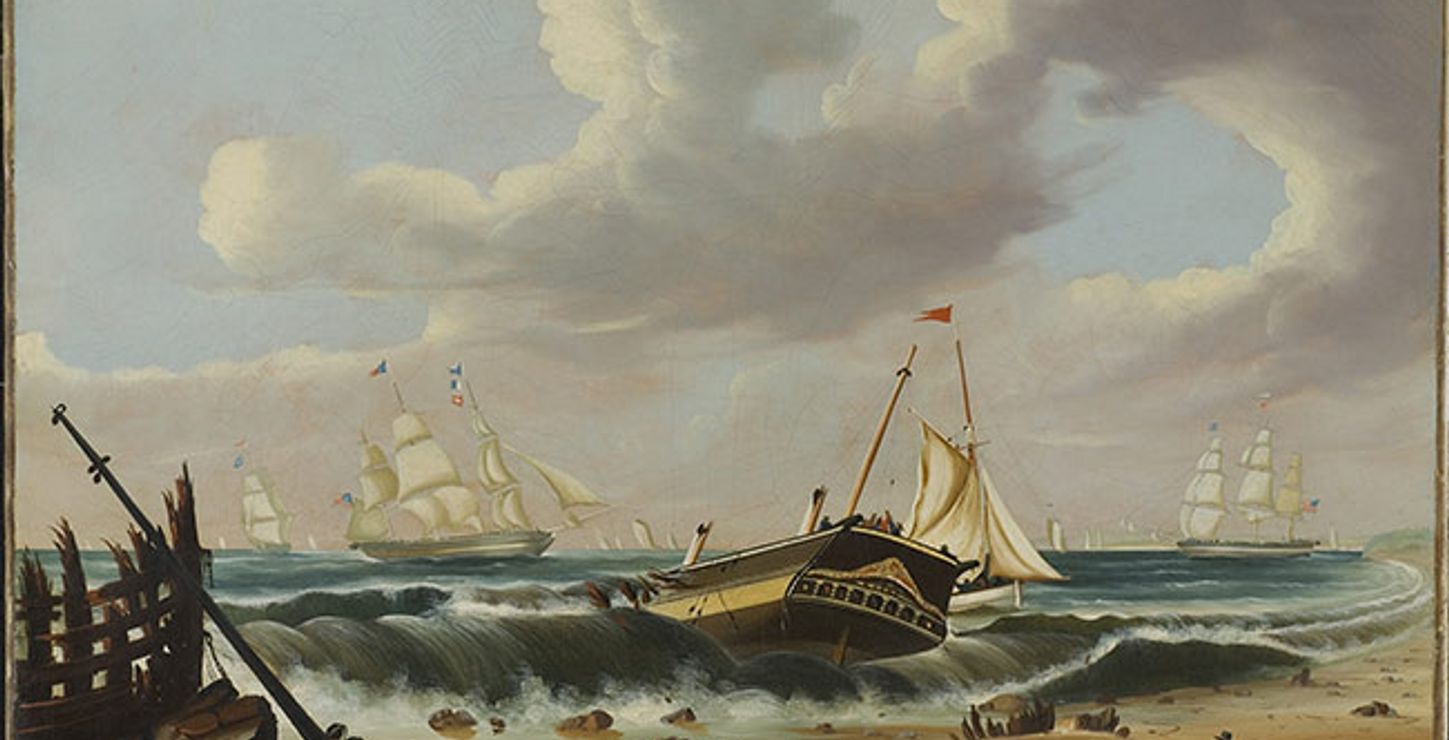Berman and Stieglitz Galleries, ground floor
Main Building

Rockaway Beach, New York, with the Wreck of the Ship Bristol Thomas Chambers, American (born England) Oil on canvas 21 3/4 x 30 3/8 inches (55.2 x 77.2 cm) Indiana University Art Museum, Bloomington Morton and Marie Bradley Memorial Collection
This exhibition—the first major survey of Thomas Chambers's work since 1942—seeks to define his style, examine his sources, and investigate the popular audience for marine and landscape painting in the mid-nineteenth century. Active for almost three decades as a painter, Chambers left behind a boldly expressive and puzzling body of work. Recovered from obscurity in the mid-twentieth century, he was enthusiastically celebrated as an American folk painter whose rhythmic sense of contour, lively pattern, and strong color anticipated modern taste. Approximately sixty objects, borrowed from public and private collections throughout the United States, are on display, including forty-five paintings by Chambers and fifteen related paintings by his contemporaries, plus books, furniture, and ceramics decorated in the same lively style.
This exhibition is organized by the Philadelphia Museum of Art and its Center for American Art, in association with the Indiana University Art Museum, and with the support of a generous gift from Mr. and Mrs. William C. Buck.
Philadelphia Museum of Art • September 27–December 28, 2008
Hyde Collection, Glens Falls, New York • February 8–April 19, 2009
American Folk Art Museum, New York • September 29, 2009–March 7, 2010
Indiana University Art Museum, Bloomington, Indiana • March 26–May 30, 2010
Berman and Stieglitz Galleries, ground floor
Main Building
Thomas Chambers's distinctive paintings are well-known and have been reproduced in numerous surveys of American folk art, but study of the artist has been hindered by the lack of information about his life and the fact that so few of his paintings are signed and dated. Newly-discovered documents now suggest that he was the younger brother of the English marine painter, George Chambers (1803–1840), and part of an extended family of sailors and painters in Whitby, on the north coast of England. Born in 1808, Thomas Chambers evidently returned to Whitby, where he was buried in a pauper's grave in 1869. His brother George began his working life on a coal transport and gradually moved from painting trunks and buckets to ship's portraits, theatrical scenery, panoramas, and ultimately, fine art marine paintings for the king and the Royal Academy. The influence of George's early professional training in decorative painting explains much about Thomas Chambers' style; perhaps he learned to paint from his brother and followed in his path to London, but with different luck, personality, or ambition, found a market for his work in the United States.
Chambers arrived in New Orleans in 1832 and then moved to New York, listing himself as a landscape and marine painter in the city's directories between 1834 and 1840. After a brief stint in Baltimore, he moved to Boston from 1843 to 1851, and then settled in Albany from 1851 to 1857 before returning to New York. Although resident in these large cities, Chambers never exhibited at any of the official art organizations of the period and seemingly existed on the edge of the cosmopolitan art community. Since many of his paintings were discovered in the countryside of New York and western Massachusetts, it seems likely that he worked as an itinerant artist. A newfound advertisement of his work as a fancy painter and evidence of his auction sales in New York and Rhode Island tell us more about his work and his customers.
The auction listings tell us that Chambers considered himself primarily a marine painter, and was most proud of his original harbor views and battle subjects, which he very occasionally signed and dated. His landscape paintings, usually based on contemporary print sources, seem to have been his most lucrative work. Painted in one of three standard sizes and almost never signed, these paintings show an astute awareness of popular culture, a flamboyant sense of color and design, and a pioneering wish to bring landscape painting to a new audience.
Chambers's self-description as a fancy painter links him to other fine artists in the period, who often learned their trade in sign-painting workshops, and who composed similar imaginative subjects. In another direction, fancy painting allies Chambers to the large community of decorative artists who ornamented furniture, ceramics, window shades, and clocks in this period. In this exhibition, a selection of paintings and decorative arts in the fancy taste will illustrate the range from Thomas Cole and Edward Hicks to Tucker porcelain and faux-grained chests—a spectrum that united all the painted artifacts of this exuberant period in American art. An enterprising artist bridging the territory between fine and folk art, Chambers can be understood as a unique figure in the development of popular marine and landscape painting in nineteenth-century America. From a wider perspective, the exhibition also offers a chance to place Chambers within the history of the appreciation for American folk art that arose in the early twentieth century and continues to flourish today.
Kathleen A. Foster • The Robert L. McNeil, Jr., Senior Curator of American Art and Director, Center for American Art